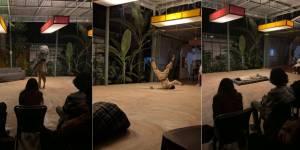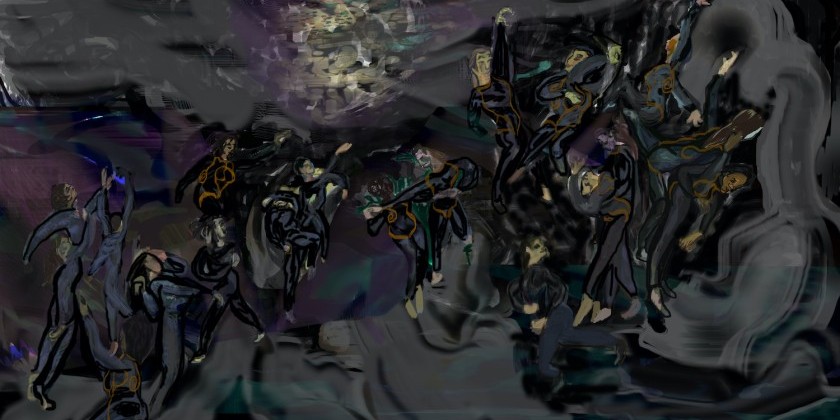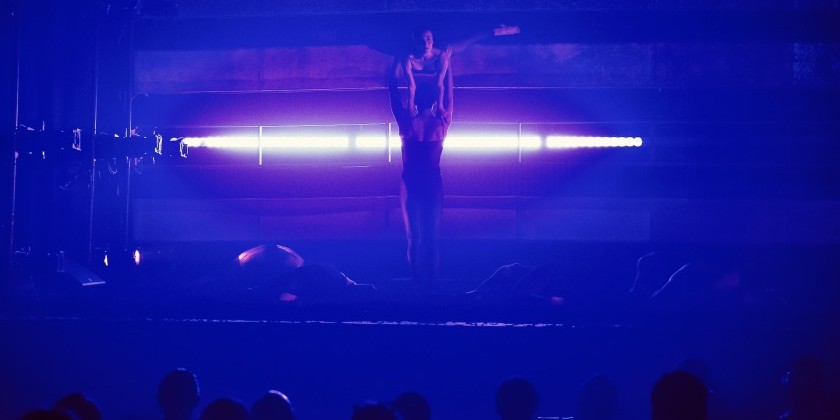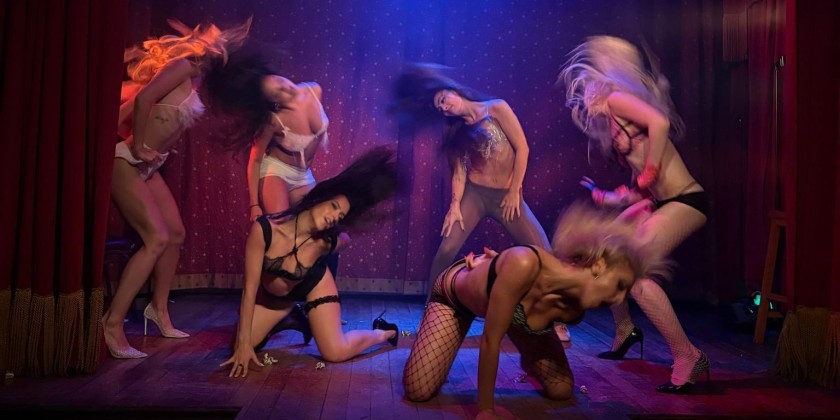AUDIENCE REVIEW: Verbal Animal in "triptych, mirrored"
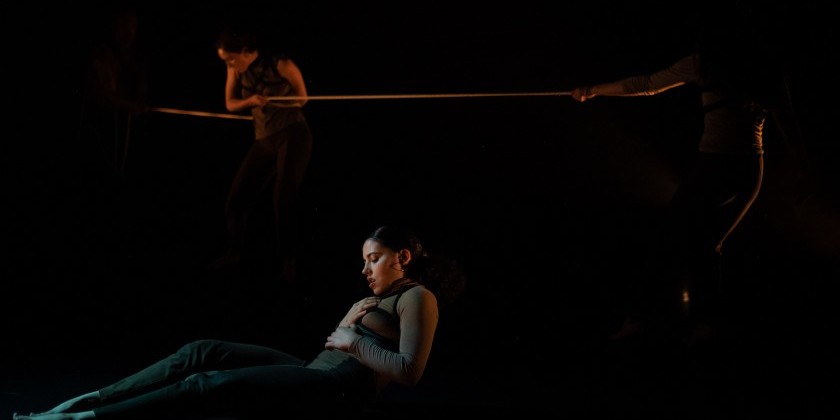
Company:
VERBAL ANIMAL
Performance Date:
May 26-28, 2022
Freeform Review:
triptych, mirrored is a contemporary interdisciplinary work by the artists of VERBAL ANIMAL: Lavy, Beatriz Castro, Abigail Rose, Bailey Yates, and Cassidy Grady, along with Shibari Artist, Ester Shmulyian and Sound Designer, Levi Thompson.
triptych, mirrored is an evening length work divided into six seamless sections. The first three sections create a triptych with Freedom, Pleasure, and Torment, which are then mirrored following the intermission beginning with Torment then Pleasure and Freedom. To the audience member viewing for the first time, the distinction between the sections aforementioned is not always clear.
The stage was set with a single rope placed at the downstage center. The performance began with an outside body (Ester Shmulyian) entering the performance space from the house; she is in a slip dress and wears a pair of heels that make a distinct clicking sound as she enters. She unfurls the rope meticulously, dragging it up the steps of the risers, ensuring it maintains a clean, straight line. She walks back down the stairs, takes off the heels and sets them offstage right. The dancers enter from a part in the center of the scrim all the way upstage. Together with Shmulyian, they create a single file horizontal line. Lavy, Castro, and Yates are tied in with a rope bodice, while Rose and Grady remain bare.
The audience witnesses Rose beginning pulling the rope slowly and steadily, dragging it down the steps next to their seats all the way on stage. The piece begins and we are already fully immersed.
The difference between the tethered and untethered dancers is subtle, yet apparent. There is a structure or boundness to the three we see tied in, and a freeness felt through the two that are bare. The movement quality of Verbal Animal is established here, strong and embodied, physical and rhythmic. Shmulyian ties Grady and Rose live on stage. The audience watches as these two, who began bare, join the rest of the company with rope bodices. It is apparent that these two complete the collective, and those onstage become a unit. This fulfills Chapter One: Freedom | “I, You, I” and Chapter Two: Pleasure | “You’re not One.”
Chapter Three: Torment | “I’ve never been to Texas” comes in with an old timey western tune. This is a drastic change from the instrumental beats that existed prior. The shift comes out of nowhere and asks the audience to come along for the ride. While there was no obvious reason for this shift, the confusion felt by the audience did not take away from the digestion of the work. The artists maintain their very physical and rhythmic movement, which creates an unexpectedly satisfying pairing.
Following intermission, Chapter Four: Torment | “You’ve never been to Texas,” begins the mirroring of the first three sections. All five dancers are lit onstage with red-tinted lights. They use their own bodies as percussive instruments, creating an embodied rhythm in the movement. We see the artists as a unified collective again, creating a powerful image of their bodies in space. The role of Texas remains unclear, allowing for audience interpretation. The dancers close this section in a circle, emphasizing their connection, but begin to peel away one by one.
Castro and Yates find themselves on the floor stage right, while Rose and Lavy continue moving upstage. Here, a dichotomy is seen between the pleasure of the ground and the freedom of the vertical space. This is a common thread throughout the work. Chapter Five: Pleasure | “I can fit a lot in my mouth,” is showcased in the movements of Castro and Yates on the floor as it was in Chapter Two. The difference from Chapter Five appears to be the subject. “I can fit a lot in my mouth” takes ownership of self, whereas “You’re not the One” others the pleasure to an external point. We see in their movements in Chapter Five that they feel pleasure as a result of their own selves.
Grady enters from the parting in the scrim with the rope. Shmulyian begins to tie Yates on the ground. This tying appears more restrictive than the ties seen in Chapter One. Yates remains submissive on the ground, while Castro continues into the vertical space. Perhaps this serves as a precursor for the next chapter, as Yates sits into the pleasure on the floor, Castro begins to find freedom above. Castro’s solo proves to be immensely dynamic, floating across the stage. She embodies the movement vocabulary already established throughout the performance with true ownership and confidence. All eyes are on her, and Castro uses this power to bring the audience into another world as they transition into the last chapter of the piece. Castro and Grady trace the rope offstage where the rope is pulled from, lifting Yates up and across the stage. She is shown struggling, moving in opposition to the rope's direction, as if she would like to break free. She is taken all the way offstage by the pull of the rope, and just before it feels like it is all over, Lavy, Rose, and Castro burst back on.
This trio remains incredibly physical, moving in and out of the floor. The torment, pleasure, and freedom is present in all that they do. Chapter Six: Freedom | “I end where you begin,” suggests a full circle journey, which is apparent. triptych, mirrored closes as it began. Shmulyian realigns the rope through the audience, and Rose pulls it back towards the artists. They end where they begin, but the passage from beginning to end is palpable in the space.
Author:
Maya Lam
Photo Credit:
Nir Arieli




